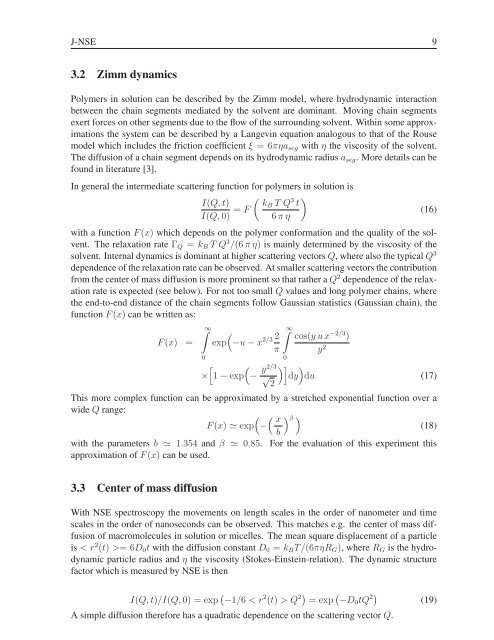Neutron Scattering - JUWEL - Forschungszentrum Jülich
Neutron Scattering - JUWEL - Forschungszentrum Jülich
Neutron Scattering - JUWEL - Forschungszentrum Jülich
Create successful ePaper yourself
Turn your PDF publications into a flip-book with our unique Google optimized e-Paper software.
J-NSE 9<br />
3.2 Zimm dynamics<br />
Polymers in solution can be described by the Zimm model, where hydrodynamic interaction<br />
between the chain segments mediated by the solvent are dominant. Moving chain segments<br />
exert forces on other segments due to the flow of the surrounding solvent. Within some approximations<br />
the system can be described by a Langevin equation analogous to that of the Rouse<br />
model which includes the friction coefficient ξ =6πηaseg with η the viscosity of the solvent.<br />
The diffusion of a chain segment depends on its hydrodynamic radius aseg. More details can be<br />
found in literature [3].<br />
In general the intermediate scattering function for polymers in solution is<br />
�<br />
I(Q, t) kB TQ<br />
= F<br />
I(Q, 0) 3 �<br />
t<br />
(16)<br />
6 πη<br />
with a function F (x) which depends on the polymer conformation and the quality of the solvent.<br />
The relaxation rate ΓQ = kB TQ3 /(6 πη) is mainly determined by the viscosity of the<br />
solvent. Internal dynamics is dominant at higher scattering vectors Q, where also the typical Q3 dependence of the relaxation rate can be observed. At smaller scattering vectors the contribution<br />
from the center of mass diffusion is more prominent so that rather a Q2 dependence of the relaxation<br />
rate is expected (see below). For not too small Q values and long polymer chains, where<br />
the end-to-end distance of the chain segments follow Gaussian statistics (Gaussian chain), the<br />
function F (x) can be written as:<br />
F (x) =<br />
�∞<br />
0<br />
�<br />
2/3 2<br />
exp −u − x<br />
π<br />
�∞<br />
0<br />
cos(yux −2/3 )<br />
y 2<br />
� �<br />
× 1 − exp − y2/3<br />
�� �<br />
√ dy du<br />
2<br />
(17)<br />
This more complex function can be approximated by a stretched exponential function over a<br />
wide Q range:<br />
� �<br />
x<br />
�β �<br />
F (x) � exp −<br />
b<br />
(18)<br />
with the parameters b � 1.354 and β � 0.85.<br />
approximation of F (x) can be used.<br />
For the evaluation of this experiment this<br />
3.3 Center of mass diffusion<br />
With NSE spectroscopy the movements on length scales in the order of nanometer and time<br />
scales in the order of nanoseconds can be observed. This matches e.g. the center of mass diffusion<br />
of macromolecules in solution or micelles. The mean square displacement of a particle<br />
is = 6D0t with the diffusion constant D0 = kBT/(6πηRG), where RG is the hydrodynamic<br />
particle radius and η the viscosity (Stokes-Einstein-relation). The dynamic structure<br />
factor which is measured by NSE is then<br />
I(Q, t)/I(Q, 0) = exp � −1/6 Q 2� =exp � −D0tQ 2�<br />
Asimple diffusion therefore has a quadratic dependence on the scattering vector Q.<br />
(19)

















